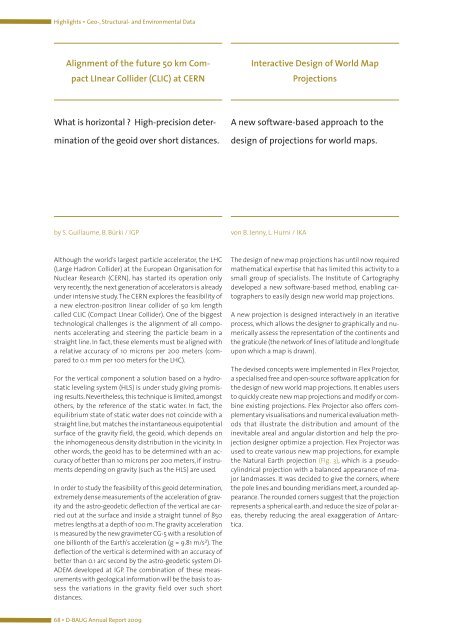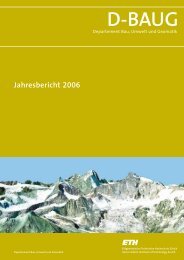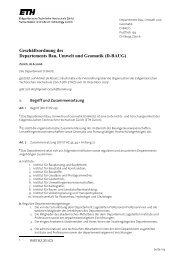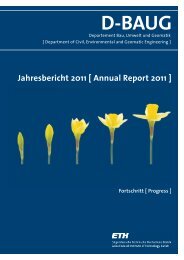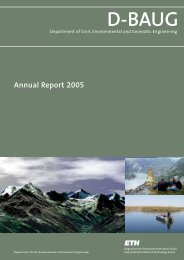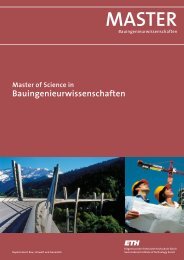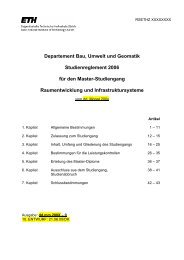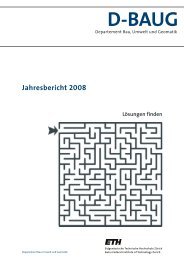D-BAUG - Departement Bau, Umwelt und Geomatik - ETH Zürich
D-BAUG - Departement Bau, Umwelt und Geomatik - ETH Zürich
D-BAUG - Departement Bau, Umwelt und Geomatik - ETH Zürich
Create successful ePaper yourself
Turn your PDF publications into a flip-book with our unique Google optimized e-Paper software.
Highlights ▪ Geo-, Structural- and Environmental Data<br />
Alignment of the future 50 km Compact<br />
LInear Collider (CLIC) at CERN<br />
What is horizontal ? High-precision deter-<br />
mination of the geoid over short distances.<br />
Although the world’s largest particle accelerator, the LHC<br />
(Large Hadron Collider) at the European Organisation for<br />
Nuclear Research (CERN), has started its operation only<br />
very recently, the next generation of accelerators is already<br />
<strong>und</strong>er intensive study.The CERN explores the feasibility of<br />
a new electron-positron linear collider of 50 km length<br />
called CLIC (Compact LInear Collider). One of the biggest<br />
technological challenges is the alignment of all components<br />
accelerating and steering the particle beam in a<br />
straight line. In fact, these elements must be aligned with<br />
a relative accuracy of 10 microns per 200 meters (compared<br />
to 0.1 mm per 100 meters for the LHC).<br />
For the vertical component a solution based on a hydrostatic<br />
leveling system (HLS) is <strong>und</strong>er study giving promising<br />
results. Nevertheless, this technique is limited, amongst<br />
others, by the reference of the static water. In fact, the<br />
equilibrium state of static water does not coincide with a<br />
straight line, but matches the instantaneous equipotential<br />
surface of the gravity field, the geoid, which depends on<br />
the inhomogeneous density distribution in the vicinity. In<br />
other words, the geoid has to be determined with an accuracy<br />
of better than 10 microns per 200 meters, if instruments<br />
depending on gravity (such as the HLS) are used.<br />
In order to study the feasibility of this geoid determination,<br />
extremely dense measurements of the acceleration of gravity<br />
and the astro-geodetic deflection of the vertical are carried<br />
out at the surface and inside a straight tunnel of 850<br />
metres lengths at a depth of 100 m.The gravity acceleration<br />
is measured by the new gravimeter CG-5 with a resolution of<br />
one billionth of the Earth’s acceleration (g ≈ 9.81 m/s 2 ). The<br />
deflection of the vertical is determined with an accuracy of<br />
better than 0.1 arc second by the astro-geodetic system DI-<br />
ADEM developed at IGP. The combination of these measurements<br />
with geological information will be the basis to assess<br />
the variations in the gravity field over such short<br />
distances.<br />
68 ▪ D-<strong>BAUG</strong> Annual Report 2009<br />
Interactive Design of World Map<br />
Projections<br />
A new software-based approach to the<br />
design of projections for world maps.<br />
by S. Guillaume, B. Bürki / IGP von B. Jenny, L. Hurni / IKA<br />
The design of new map projections has until now required<br />
mathematical expertise that has limited this activity to a<br />
small group of specialists. The Institute of Cartography<br />
developed a new software-based method, enabling cartographers<br />
to easily design new world map projections.<br />
A new projection is designed interactively in an iterative<br />
process, which allows the designer to graphically and numerically<br />
assess the representation of the continents and<br />
the graticule (the network of lines of latitude and longitude<br />
upon which a map is drawn).<br />
The devised concepts were implemented in Flex Projector,<br />
a specialised free and open-source software application for<br />
the design of new world map projections. It enables users<br />
to quickly create new map projections and modify or combine<br />
existing projections. Flex Projector also offers complementary<br />
visualisations and numerical evaluation methods<br />
that illustrate the distribution and amount of the<br />
inevitable areal and angular distortion and help the projection<br />
designer optimize a projection. Flex Projector was<br />
used to create various new map projections, for example<br />
the Natural Earth projection (Fig. 3), which is a pseudocylindrical<br />
projection with a balanced appearance of major<br />
landmasses. It was decided to give the corners, where<br />
the pole lines and bo<strong>und</strong>ing meridians meet, a ro<strong>und</strong>ed appearance.<br />
The ro<strong>und</strong>ed corners suggest that the projection<br />
represents a spherical earth, and reduce the size of polar areas,<br />
thereby reducing the areal exaggeration of Antarctica.


